
 |
 |
| The grinding of mole ingredients is a culinary ritual in Mexico. |
 hen Mexico’s leading writer, Nobel Prize laureate Octavio Paz, arrived in New Delhi in 1962 to take up his post as ambassador to India, he quickly ran across a culinary puzzle. Although Mexico and India were on opposite sides of the globe, the brown, spicy, aromatic curries that he was offered in India sparked memories of Mexico’s national dish, mole (pronounced MO-lay). Is mole, he wondered, “an ingenious Mexican version of curry, or is curry a Hindu adaptation of a Mexican sauce?” How could this seeming coincidence of “gastronomic geography” be explained?
hen Mexico’s leading writer, Nobel Prize laureate Octavio Paz, arrived in New Delhi in 1962 to take up his post as ambassador to India, he quickly ran across a culinary puzzle. Although Mexico and India were on opposite sides of the globe, the brown, spicy, aromatic curries that he was offered in India sparked memories of Mexico’s national dish, mole (pronounced MO-lay). Is mole, he wondered, “an ingenious Mexican version of curry, or is curry a Hindu adaptation of a Mexican sauce?” How could this seeming coincidence of “gastronomic geography” be explained?
For a Mexican, this was no trivial matter. Laborious to produce, mole is served for weddings, festivals and national holidays. The legend of its origin in the convents of 18th-century Puebla, the second city of New Spain—as Mexico was then called—is part of the nation’s popular history, recounted time and again in newspapers, school textbooks, guidebooks and even on paper placemats in restaurants. Mole comes in many varieties, but it usually contains ingredients such as cinnamon, cloves, peppercorns, anise, coriander, chocolate, chiles, almonds, pumpkin seeds, raisins, bread and tortillas—all ground together and cooked in a light broth to make a harmonious brown sauce that is served with turkey, chicken or vegetable dishes.
Chocolate seems a curious ingredient to non-Mexicans—indeed, outside Mexico mole is sometimes referred to as a chocolate sauce—but in fact not all moles contain chocolate and even those that do use it in small quantities to balance the flavor of the other spices. More complex and less piquant than the better-known, fiery, tomato-based sauces that have spread around the world with Tex-Mex cuisine, mole, as Paz observed, does have a color, flavor and texture reminiscent of many of the Indian dishes collectively known as curries in the rest of the world. And in raising the question of the uniqueness of mole, Paz was challenging the idea that mole was the cornerstone of a uniquely Mexican culinary heritage.
But while Paz was right to point out that mole resembled curry, he was wrong to imagine that Mexican cooks had created mole as imitation curry, or that Indian cooks composed curries in an effort to emulate mole. He would have done better to picture both moles and curries as vestiges of the cuisine of medieval Islam, a cuisine that was enjoyed from southern Spain in the west to northern India in the east.
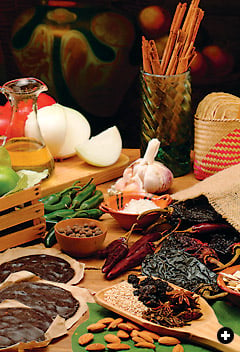 |
 |
| The most common ingredients for the endless varieties of mole include (from top left in a clockwise spiral) tomato, onion, cinnamon, tortillas, chiles—including anchos, pasillas, mulattos and chipotles—pumpkin seeds, raisins, star anise, cloves, sesame seeds, almonds, tablets of chocolate, tomatillos, oil, garlic, salt, allspice and serrano chiles. Nearly half these ingredients arrived in the New World with the Spanish. |
 he high cuisine of medieval Islam, one of the most sophisticated the world had seen, flourished from the eighth century on. It originated in Baghdad, where cooks had the advantage of being able to adapt a Persian cuisine that had developed over the past thousand years, and it was quickly adopted in the other cities of Islam. With the diffusion of Islam, the cuisine was transplanted to new territories. One of the most important was the Iberian Peninsula, whose southern two-thirds came under Arab rule in the eighth century. Watered by five rivers and greener than either their arid homelands or the other lands they had conquered, al-Andalus, as Muslim Spain was called, held out to the Arab and Berber settlers the promise of being a culinary paradise on earth. In the valleys, farmers grew wheat, grapes and olives. In the hills, shepherds tended the sheep and goats that the Arabs favored for meat dishes.
he high cuisine of medieval Islam, one of the most sophisticated the world had seen, flourished from the eighth century on. It originated in Baghdad, where cooks had the advantage of being able to adapt a Persian cuisine that had developed over the past thousand years, and it was quickly adopted in the other cities of Islam. With the diffusion of Islam, the cuisine was transplanted to new territories. One of the most important was the Iberian Peninsula, whose southern two-thirds came under Arab rule in the eighth century. Watered by five rivers and greener than either their arid homelands or the other lands they had conquered, al-Andalus, as Muslim Spain was called, held out to the Arab and Berber settlers the promise of being a culinary paradise on earth. In the valleys, farmers grew wheat, grapes and olives. In the hills, shepherds tended the sheep and goats that the Arabs favored for meat dishes.
But other culinary resources that the Arab elite had come to expect were lacking. The settlers immediately set about correcting this, transforming the landscape of al-Andalus and the cuisine it supported. They built stone irrigation channels through orchards and fields and filled them with river water raised by towering water wheels (norias). They installed walled gardens (huertas) where they could raise slips and cuttings of their favorite fruit trees. As early as the eighth century, the amir ‘Abd al-Rahman I introduced the date palm into Spain, and he happily accepted a pomegranate variety from Damascus offered to him by the chief judge of Córdoba. A century later the poet al-Ghazal returned from a mission to the East with a fine fig cultivar that he had smuggled out of Constantinople in a package of books.
The Muslims also introduced rice for fine pilafs, sugar for drinks and sweets, saffron to add aroma and color to their dishes and a wide variety of their favorite fruits and vegetables, including apricots, oranges, limes, artichokes, carrots, spinach and eggplant. They grew coriander, mint, thyme, fennel, cumin and caraway; the spices and aromatics that they could not grow—such as black pepper, cinnamon, spikenard, ginger, cloves, nutmeg, galingale, musk and camphor—they imported.
As in the rest of Islam, the Spanish Muslims built granaries (alhóndigas) to store grain to be distributed in case of hardship. And they set up their characteristic food-processing plants: distilleries to produce rose- and orange-blossom water to perfume their foods and refineries to make fine white sugar.
| Distant cousins of Persian and Mesopotamian ancestors are, at right, the diverse Indian family of sauced-meat dishes known as curry, represented here by rogan josh, and the four major families of Mexican moles, below. For both, it is the sauce that carries the dish’s name, and both are made with diverse ingredients. Below, from left: Red mole is nationally popular but best known in central Mexico, and it is shown here with cubed beef, onion and carrots. Yellow mole is typical of the southern state of Oaxaca, here served with shredded beef and green beans. Green mole is common on the Gulf coast, where it might be served over chicken with chayotes (also called christophine, vegetable pear or mirliton), corn and ring-shaped corn dumplings. Mole poblano is from Puebla, near Mexico City, and it is the best known of the moles for its use of chocolate—a uniquely New World variation. |
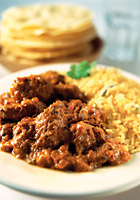 |
 |
|
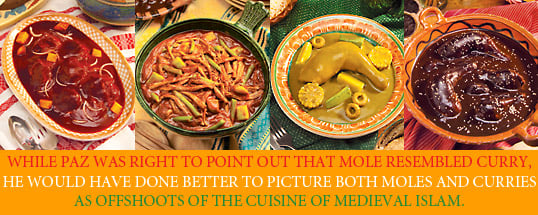 |
In the court kitchens of Córdoba and Granada, cooks could now produce the dishes of high Islamic cuisine. There were the pilaus, made by frying rice or thin wheat noodles and then simmering them in an aromatic liquid until it was fully absorbed. Another family of dishes consisted of delicate dumplings (albondigas) of meats pounded with seasonings. And there were the most characteristic meat dishes: meltingly tender spicy stews. Flavored with a variety of herbs and spices, these stews were cooked in earthenware pots nestled in circular holes in charcoal-heated masonry bench stoves. Some were green with spinach and coriander. Others were golden with saffron. And the most complex were flavored with cinnamon, cloves, peppercorns, almonds and raisins and thickened with eggs or breadcrumbs.
Other great creations of the Muslim kitchen were based on clarified white sugar. Sweetened drinks (sharbat) were flavored with ground nuts, citrus fruits and pomegranates. Jams were made of rose petals, oranges and apricots, and dense pastes of quinces. Figurines were modeled from a white paste of sugar mixed with gum (alfenique). And a wide variety of confections such as marzipan was created from sugar and nuts.
It is small wonder that Spanish Christians eyed the cuisine of the Muslims with envy. Over the centuries, they adopted their rice and noodle pilaus, their albondigas, their aromatic stews of lamb, kid and chicken, and their sharbats, jams, fruit pastes, alfenique and marzipan. The modifications that they introduced, such as adding pork to the list of meats, baking raised breads instead of flat breads and distilling wine and molasses instead of flower petals, did not change the basic structure of the cuisine. By the late Middle Ages, this Christian version of the cuisine of al-Andalus was famous as the finest in Europe. In 1611, Francisco Martínez Montiño, the head cook of King Philip III, recorded it in the 500 densely packed pages of his Arte de Cocina, Pasteleria, Vizcocheria, y Conserveria (Art of Cooking, Cake Making, Biscuit Making and Conserving).
 |
| The influential Persian culinary tradition is yet to be studied in detail. When the Abbasid dynasty established its capital in Baghdad in the eighth century, the Islamic world was able to draw on a sophisticated Persian culinary tradition that stretched back a millennium. The ancient Greeks had been awed by the luxurious cuisine of the Persian emperors Darius and Cyrus. Successive dynasties had continued to refine the cuisine that became the model for fine dining throughout the Islamic world. After the Mongols destroyed Baghdad in the first half of the 13th century, the center of Persian culture and its cuisine shifted back to the Persian heartland. It was here that the Moghuls learned the style of cooking that they took with them to northern India. |
 lmost a century earlier, Christian Spanish cuisine had already reached the Americas. In 1492—the very year in which the Christians took Granada, the last Muslim outpost in al-Andalus—Columbus had set sail. Within 30 years, Cortés had captured Tenochtitlán, the Aztec capital that we now know as Mexico City. He sent back glowing reports of the lavish banquets of Moctezuma as proof that he had conquered a rich and powerful empire. But he and his men had embarked on their perilous adventure to create a New Spain, and they had not the slightest intention of adopting Aztec cuisine, with its maize (corn) flatbreads and unfamiliar dishes. They were going to replicate the cuisine of their homeland.
lmost a century earlier, Christian Spanish cuisine had already reached the Americas. In 1492—the very year in which the Christians took Granada, the last Muslim outpost in al-Andalus—Columbus had set sail. Within 30 years, Cortés had captured Tenochtitlán, the Aztec capital that we now know as Mexico City. He sent back glowing reports of the lavish banquets of Moctezuma as proof that he had conquered a rich and powerful empire. But he and his men had embarked on their perilous adventure to create a New Spain, and they had not the slightest intention of adopting Aztec cuisine, with its maize (corn) flatbreads and unfamiliar dishes. They were going to replicate the cuisine of their homeland.
So once more, the cuisine of medieval Islam was transplanted. Within five years of arriving in Mexico, Cortés had established a sugar plantation. Galleons arrived from Spain laden with seed wheat, sheep, goats and cattle, and wooden planters carrying citrus, fig and pomegranate trees. Within a generation or two, the culinary landscape of Mexico had been transformed to resemble that of the Islamic world. Shepherds followed their flocks through the dry scrub on the mountain slopes of central Mexico. Stone irrigation channels filled by the traditional noria threaded their way across the landscape. Fields of foreign wheat jostled against fields of native maize. Rice was well established. Towns constructed alhóndigas to store these grains. Stills transformed molasses into aguardiente and refineries processed sugar for confectionary.
 |
| Above, left: Mexican aguas frescas are descendants of the sharbat of the East, the ancestor of “sherbet.” The jugs here likely include popular favorites such as watermelon, hibiscus, horchata, tamarind and—a favorite fruit in the early Islamic era—melon. Above, right: “Spanish rice” is sopa seca, literally “dry soup,” a quintessentially Mexican dish that is descended from the Asian pilau (pilaf) in which the rice is first fried and then simmered in spiced or flavored water. |
The houses of Mexico, like those of much of Islam, presented blank walls to the street. But behind the doors and central courtyard were huertas filled with trees heavy with limes, pomegranates, quinces and figs. Inside, the kitchens were equipped with masonry bench stoves covered with Islamic-style tiles. Niches in the walls held pottery canisters of cinnamon, cloves, thyme and black pepper. The wealthiest kitchens boasted copies of Martínez Montiño’s Art of Cooking; others relied on manuscript recipe collections that still survive today.
In these kitchens, the cooks of New Spain adapted the medieval Islamic cuisine of al-Andalus to the resources of Mexico. They substituted turkey and other American game for the stewed chickens or roasted partridges of Spain. They used indigenous beans as well as the traditional Iberian chickpeas. They added tomatillos to green sauces, annatto to golden sauces and, in a pinch, replaced almonds with peanuts or pumpkin seeds. Native fruits, such as guava, cherimoya and cactus, as well as introduced citrus and quinces, went into confectionary and drinks. They adopted spiced chocolate as a hot drink and, occasionally, as a spice too. Most important, they substituted chiles for black pepper.
In one set of manuscripts, the Recetario de Dominga de Guzmán (Recipe Book of Dominga de Guzmán), compiled around 1750, it is possible to catch a glimpse of the cook in the act of adapting the traditional dishes of al-Andalus to the circumstances of New Spain. In the first of two recipes for braised fowl, the ingredients include onion, oregano, mint, parsley, garlic, cumin, ham, sausage, cloves, cinnamon, black pepper and capers. This is simply titled “Morisco” to indicate Muslim origins—although the ham and the sausage are obviously Christian, not Muslim. The second, called “Mestizo” or “mixed race,” drops the typically Islamic cloves, cinnamon and black pepper and substitutes Mexican tomatoes and chiles.
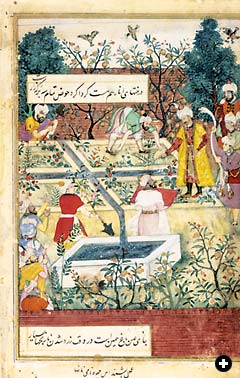 |
 |
| The agricultural technology first developed in Persia and Mesopotamia traveled both to the New World with the Spanish and east to Afghanistan and India with Babur, founder of the Mughal Dynasty. To “New Spain”—as the Spanish called it—the colonizers brought sugar, wheat, sheep, goats, cattle and fig and pomegranate trees, transplanting as much of al-Andalus as galleons could carry and Mexican soil could grow; for his part, Babur was renowned for his irrigated gardens that were as important for their products as for the pleasure they provided. |
Sometime in the 18th century, though, the brown sauces took on the collective name mole, even though some of the older Spanish names also persisted. Mole had multiple resonances in the Mexican kitchen. In the Aztec language, Nahuatl, still spoken by many servants, molli meant “sauce.” In Portuguese, mollo (pronounced something like “molio” in English) also meant “sauce,” and many recipes in Martínez Montiño’s collection went by this name. And in Spanish, moler means “to grind,” the crucial technique used in preparing these sauces. Mole therefore was a word easily recognizable by everyone in the kitchen and one that made it easy for the mistress of a house or a head cook to communicate with the servants who carried out all the menial tasks.
But for all these substitutions and changes in terminology, the basic techniques and structure of the Islamic cuisine persisted in New Spain. The manuscript cookbooks contain recipes for pilaus of rice or thin noodles that could have come straight from the court of Córdoba. So too could the acidic, herby green sauces, rich in coriander. Or the recipe for “Rabbits in Sauce” (Conejos en Mollo), consisting of a base of fried onions to which pieces of rabbit were added, seasoned with pepper, nutmeg and ginger, stewed with stock, and finished with vinegar and saffron. Or, again, the “Chicken in Nut Sauce” (Pollo en Nogada) in which quartered chickens were simmered with cloves, cinnamon, black pepper, saffron and a little vinegar, then fried and sauced with a mixture of ground cloves, cumin, garlic, breadcrumbs and nuts. And the complex, expensive confections—marzipan and nut brittles, candied fruits, luscious jams, fruit pastes and leathers and fruits preserved in syrup—not only derive from the Islamic tradition but often retained even the Arabic names, such as jarabe and almibar for syrups.
Today Mexican families still sit down to dinners that reveal their Islamic origins. They begin with a “watery” soup (sopa aguada), such as a broth with tiny albondigas. Then comes a “dry soup” (sopa seca), such as “Spanish rice,” which is none other than the pilau of the Islamic world. The main course is a piece of chicken or meat accompanied by a green sauce, a nut sauce (nogada), an almond sauce (almendrada) or a spicy reddish-brown sauce (mole). After the meal comes a quince paste, with a little fresh cheese. Accompanying the meal is a refreshing drink—an agua fresca, as the Islamic sharbat is called in Mexico—a colorful, lightly sweetened homemade beverage of lime, melon or milky ground rice with almonds and cinnamon.
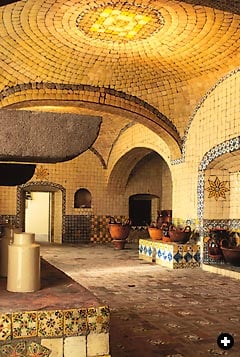 |
 |
| In Puebla, the second city of Mexico’s colonial era, the kitchen of the early-18th-century convent of Santa Rosa uses bench stoves, tile, vaults and domed ceilings in a fashion that almost replicates those of al-Andalus and North Africa. |
If, after the meal, the family takes a stroll and it is the week leading up to the Day of the Dead, they will find the streets filled with stalls selling alfenique. Households dedicated to the task have labored since the preceding year making figurines of white sugar paste, a mixture of gum from a Mexican orchid, egg whites and sugar. Children buy lambs, pigs feeding their piglets, platters of food, skulls, television sets and skeletons that pop out of coffins, all modeled from the paste, and wander along licking on their treats.
 ith this background, it takes only one more step to see why Mexican moles resemble Indian curries. In the early 16th century, as the Spaniards were introducing their version of Muslim cuisine to Mexico, the Mughals conquered northern India half a world away. They came by way of Persia, which had become the cultural and culinary center of the region since the Mongols had ruined Baghdad more than 200 years earlier. It was this Persian version of Muslim cuisine that their cooks adapted to Indian circumstances, creating the sophisticated Mughal cuisine of New Delhi. By the mid-16th century, then, a belt of high cuisine could be traced from northern India westward to Mexico. Although in every area it had been adapted to include local ingredients, the basic techniques and the basic dishes of medieval Islam continued to form the basis of all the local variants.
ith this background, it takes only one more step to see why Mexican moles resemble Indian curries. In the early 16th century, as the Spaniards were introducing their version of Muslim cuisine to Mexico, the Mughals conquered northern India half a world away. They came by way of Persia, which had become the cultural and culinary center of the region since the Mongols had ruined Baghdad more than 200 years earlier. It was this Persian version of Muslim cuisine that their cooks adapted to Indian circumstances, creating the sophisticated Mughal cuisine of New Delhi. By the mid-16th century, then, a belt of high cuisine could be traced from northern India westward to Mexico. Although in every area it had been adapted to include local ingredients, the basic techniques and the basic dishes of medieval Islam continued to form the basis of all the local variants.
Today, it is difficult to perceive this earlier global gastronomic geography. Over the centuries, one event after another clouded the simple picture of the belt of Islamic high cuisine. As time passed, Spain, northern India and Mexico all had reasons to play down the origins of their cuisines. In Spain, the growing prestige of French cookery over the 18th and 19th centuries meant that cooks and diners abandoned much of their earlier cuisine and adopted French techniques and French dishes. In 19th-century India, the British lumped all the rich stewed dishes of the Mughal court together as curries rather than using their traditional Islamic names. In the mid-20th century, independence from Britain and the partition of India and Pakistan meant that India became a predominantly Hindu nation. It was not so odd, therefore, that Octavio Paz identified the high cuisine of New Delhi, with its roots in the court cuisine of the Mughals, as made up of Hindu curries.
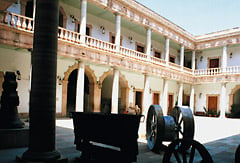 |
 |
| A parallel adaptation appears in New World courtyard architecture, exemplified by the Alhóndiga de Granaditas, a warehouse built in Guanajuato in 1798. |
In Mexico, the early 20th century saw the Mexican Revolution, which lasted the better part of 20 years and tore the country apart. Following the war, politicians and intellectuals struggled to create a sense of national unity. Among many other tactics, they turned to cooking as one of the formative national traditions, portraying their food as a mestizo cuisine in which Spanish elements were added to an Aztec base. Setting to one side the multiple derivations of the term mole, they concentrated on its Nahuatl roots. This derivation, they suggested, proved that mole was basically an Aztec sauce to which Spanish ingredients such as cloves and cinnamon had been added. The tale of the invention of mole in the convents of Puebla appeared for the first time.
Today Mexicans flock to the Alhóndiga of Guanajuato, the scene of the first successful skirmish of Mexico’s war of independence, when the insurgents dislodged the representatives of the Spanish crown who had barricaded themselves behind its massive walls. It is a national shrine, and few visitors but the occasional historians remember the Islamic origins of this former granary. Similarly, mole is celebrated as the national dish. It is of course typically Mexican. But it—and much of the rest of Mexican cuisine—has roots that go back to medieval Islam, roots that have been lost from sight. Octavio Paz was absolutely right when he detected the parallels between Mughal and Mexican cuisines: They are linked by Islam in the global gastronomic geography.
 |
Trained as a historian of science, Rachel Laudan now writes as a free-lancer on food history. She has received the Julia Child and the Sophie Coe Awards, the two major prizes in the field. She lives in Mexico. |
 |
Ignacio Urquiza (www.estudiourquiza.com) is one of Mexico’s leading photographers of food, travel and architecture. He has recently contributed to Savoring México (Williams-Sonoma) and Modern Mexican Flavors (Stewart Tabori & Chang). |